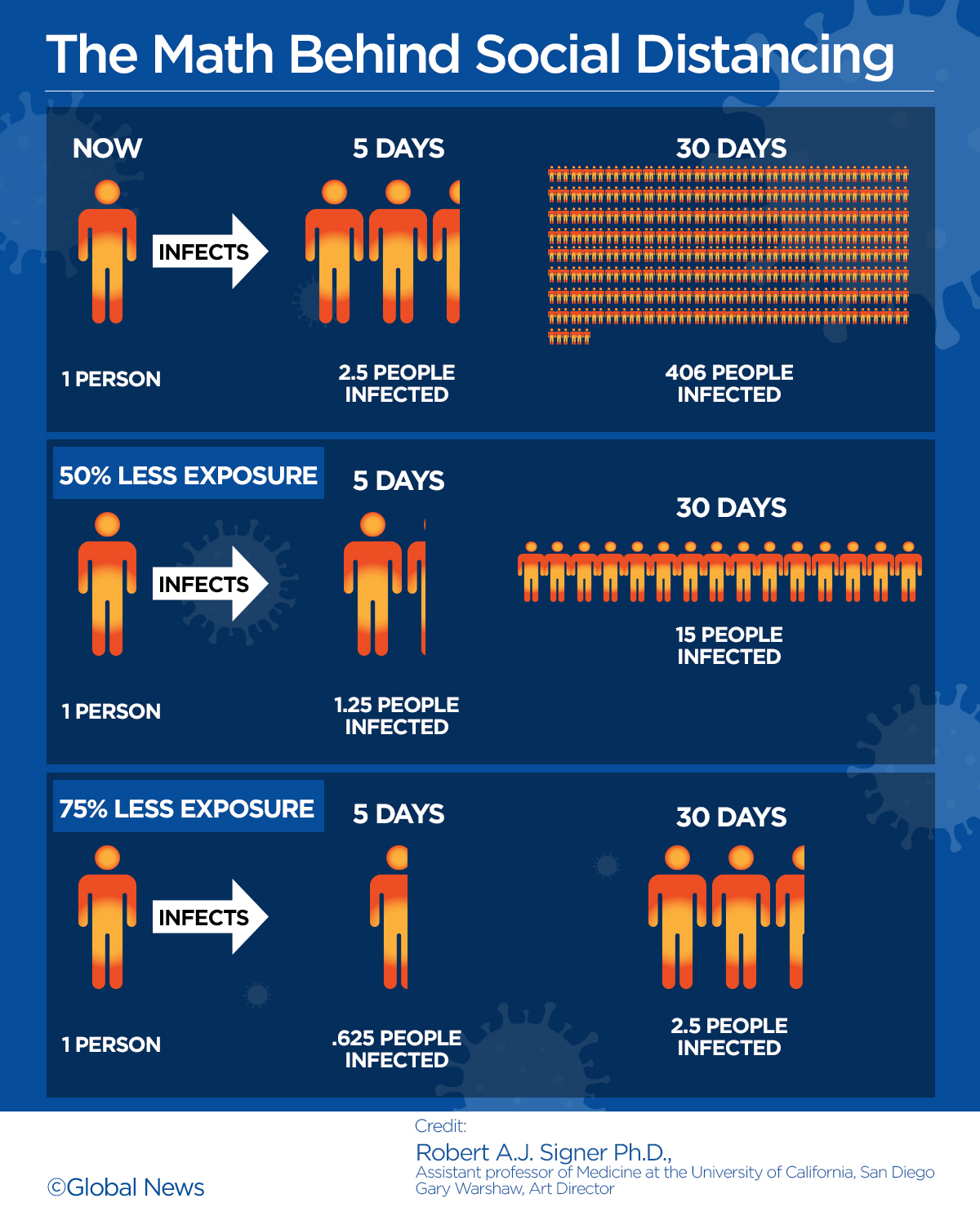By now, Canadians are well aware they should be practising social distancing amid the new coronavirus pandemic.

And there’s math behind the idea that cancelling plans, working from home and limiting interaction with others will eventually, ideally, help end the pandemic.
One graphic, created by University of California San Diego assistant professor Robert A.J. Signer and art director Gary Warshaw, shows how it works.
Signer explained to Global News that the calculations were based on initial research from officials around the world.
“There is a universal logic to this,” he said, noting that the exact numbers may vary from country to country, especially as research is done.
The infographic shows how one person who is asymptomatic for five days and doesn’t practice social distancing can spread the virus to 2.5 people.
“Initial studies have suggested that one person infected with coronavirus can transmit the virus to approximately 2.5 people,” he explained.
Signer added that initial research also shows those who tested positive for COVID-19, the disease caused by the new coronavirus, were asymptomatic for an average of five days.
“The next assumption we made is that after five days, a person will begin experiencing symptoms, will quarantine and no longer infect others,” he said.
If one person transmits the infection to an average of 2.5 people, and those 2.5 people each transmit to another 2.5 people and so on, within 30 days, 406 people would be infected.

The graphic then shows what would happen if people limited their social interaction by 50 per cent — an infected person would only transmit the virus to 1.25 people. In 30 days, 15 people would be infected.
Then, it goes on to do the same calculations, assuming the infected individual limited social interaction by 75 per cent.
That’s when the “transmission chain” would ideally end, Signer explained.
“A person can’t actually infect 0.625 people. They are either going to infect zero people, one person or more than one person,” he said. “Because there is a plausibility that some people will infect zero people, that’s when the transmission chain ends.
“Over a long period of time, this is how the pandemic disappears.”
Ashleigh Tuite, an assistant professor in the epidemiology division of the University of Toronto’s Dalla Lana School of Public Health, said the graphic lays out exactly why social distancing is so important.
“If you look at that graphic, you’re going from over 400 people infected to 2.5 people infected from that initial case. That’s a pretty dramatic impact,” she said.
“And if you expand that, if you have hundreds of thousands of cases, you could do that across all of those cases; you could have tremendous effect.”
Tuite noted that there are other ways of limiting the spread of COVID-19, including testing significantly more people and then isolating them.

“But that requires testing, which at this point is being recognized as a bit of a challenge in terms of lab capacity,” she said.
The other way, which has also been strongly advised by officials, is to practise better hygiene, such as handwashing, not touching your face and disinfecting surfaces.
Dr. Theresa Tam, Canada’s chief public health officer, has similarly said the idea behind social distancing is to avoid an exponential rise in COVID-19 cases and “flatten the curve.”
The “curve” refers to something called an epi curve, a graph line that charts the rise, peak and fall of existing infections over time.
The “flatten the curve” concept is simple: if everyone gets sick at the same time, hospitals will be overwhelmed and people will die without treatment.
However, if everyone does what they can to avoid spreading the virus and “flatten” the infection numbers on any given day, hospitals will have a better chance of giving all patients the help they need over a longer period of time.

While officials and experts advocate for social distancing, it could be months before Canadians find out how effective it has been, Tam explained on Thursday.
“What I would like to see, and I’ll be watching very closely in the next two weeks or so, what actually happens to that curve,” Tam said.
She noted that in countries such as China and South Korea, the effects of measures to contain outbreaks took more than two months to show.
“They had many, many more cases, of course, but it took them quite a few weeks and, overall, about two and a half months in order to get the bigger outbreaks under control.”
— With files from Global News’ Josh Elliot
- ‘She gets to be 10’: Ontario child’s heart donated to girl the same age
- Bird flu risk to humans an ‘enormous concern,’ WHO says. Here’s what to know
- Shoppers faces proposed class action over claims company is ‘abusive’ to pharmacists
- Most Canadian youth visit dentists, but lack of insurance a barrier






Comments